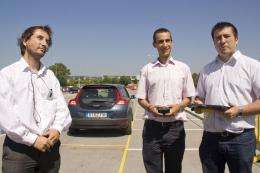New system helps locate car park spaces

A research group from the Universitat Autonoma de Barcelona, Spain, led by Jose Lopez Vicario and Antoni Morell, took part in the development of a new system which locates unoccupied car park spaces and guides users to the nearest one. The new network of sensors for the management of public car parks and locations, which researchers have named XALOC, was developed by a consortium formed by the firm WorldSensing and the Centre for Telecommunications Technology of Catalonia.
The project's consortium developed a platform based on a network of wireless sensors capable of detecting unoccupied spaces outdoors, and on an alternative positioning system with more precision in urban areas than GPS technology. This platform is capable of locating and guiding drivers to car park spaces available in the area.
The network's sensors are located on the ground directly in the middle of the car park space. The sensors detect whether the space is occupied or not and send information via internet to a central station. The server processes this information and sends it to indication panels located in the street which display the information in real time. Advanced communication techniques are used to send guidance data to the network.
The sensor platform at the same time locates users looking to park and thus offers a personalised service. UAB researchers have designed a specific portable navigator for users called ARID Navigator which makes use of communication signals belonging to the network of sensors to position users within their urban surroundings. Once the vehicle is located, the navigator communicates with XALOC's central server and reports to the user the number of available car park spaces in the area and where they are located.
The positioning and location technology used to develop the system is totally new and offers many advantages in comparison to conventional GPS navigators, such as more precise urban location techniques, reduced positioning time and better coverage.
The XALOC system will improve traffic management in urban areas and reduce what is known as "agitated traffic", traffic caused by drivers circulating and looking for a place to park. Reducing the volume of agitated traffic will allow for a substantial improvement in circulation fluidity in urban areas and thus contribute to effective reductions in pollution and an increase in citizen satisfaction.
Provided by Universitat Autonoma de Barcelona

















